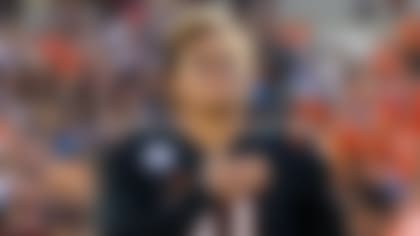Championship Sunday is finally here. This year's final four includes a Cinderella Titans squad that advanced as a No. 6 seed, a Chiefs team fresh off an improbable comeback, a new-look Packers offense that still has Aaron Rodgers at the helm and a Niners team looking for its 15th win after finishing 2018 with four victories.
With so many storylines and lenses to filter these matchups through, I'm going to use my models to identify one key potential mismatch that could heavily influence the outcome of the AFC and NFC Championship Games.
I know I talk a lot about my models, but it's in the interest of better explaining how they were made, how they evolve, what they can do and how you can use them. If you want more context about my models, you can find it below the mismatch notes.
AFC Championship Game: Tennessee Titans at Kansas City Chiefs
Potential mismatch: Derrick Henry against the Chiefs' run defense.
The Titans' run-game strategy and Derrick Henry's skill set (especially his ability to earn yards after contact) helped create the first-down and touchdown efficiency that enabled Tennessee to capitalize on the Ravens' miscues and mistakes during the Divisional Round. With at least 32 touches in each of their two underdog playoff wins, Henry posted a two-game win-share number that was not just the highest individually on his team, but also outranked all but three quarterbacks (Deshaun Watson in the Wild Card Round, Patrick Mahomes and Russell Wilson) in the eight playoff games so far.
Henry has amassed 729 of his 1,917 regular-season and playoff rushing yards when eight or more defenders have been in the box, per Next Gen Stats. This is the most yards earned against stacked boxes in the NFL by 400 yards (Sony Michel ranks second in the regular season and postseason with 329). Henry's 135 rushing attempts against stacked boxes equals the most in the NFL by 45 (again, Michel ranks second, with 90). Henry has 13 rushing touchdowns against defenses keying on him, five more than then next-closest (Dalvin Cook with eight). Henry averages 5.4 yards per attempt vs. stacked boxes, third-most in the NFL (behind San Francisco's Raheem Mostert with 6.2 and Baltimore QB Lamar Jackson with 5.9).
In the Chiefs' and Titans' Week 10 matchup, Henry faced a stacked box on only four of his rushing attempts -- and he earned 75 yards and two touchdowns on those plays, with one touchdown run being a 68-yard gash. Over the regular season and playoffs, no defense has allowed a higher per-carry average to opposing running backs when they stack the box than the Chiefs (4.7 yards). They didn't fare any better in overall run defense, allowing 4.9 yards per carry (fourth-most in the NFL). Having a healthy Chris Jones -- the defensive tackle missed Kansas City's Divisional Round win over the Texanswith a calf injury -- would be a huge help in this particular matchup.
NFC Championship Game: Green Bay Packers at San Francisco 49ers
Potential mismatch: Aaron Rodgers vs. pressure.
I'd normally name a specific defender or tandem, but in this case, it's kind of the point that against these Niners, the pressure could come from any and every direction.
Over the regular season and playoffs, Rodgers posted the fourth-lowest completion percentage among qualified quarterbacks when under pressure at 37.8 percent, per NGS. The context to consider here is that the Packers' offense was more rushing-focused in 2019 than it has been in past seasons, meaning Rodgers was in a greater number of obvious passing situations than he had been before. But even accounting for that and injuries among his wide receivers (notably the toe injury that kept Davante Adams out for four games), it is still a major source of inefficient play. The good news is, Green Bay's O-line and overall strategy have kept Rodgers from being under pressure too often. When I use computer vision to measure how often he's been disrupted (that is, when a defender entered the 5-foot halo representing the quarterback's field of vision), Rodgers ranks fifth-lowest among 35 qualified quarterbacks in the regular season and playoffs.
Rodgers' time-to-throw figure also provides extra depth to this discussion. When under pressure during the regular season and the playoffs, No. 12 held on to the ball for an average of 3.8 seconds, the longest in the NFL, per NGS. The clue here is to look into whether he was holding on to the ball too long. Watching and charting all of his throws under pressure (during the regular season and the playoffs) with one of my coaches confirmed that the potential pass-catchers on the field faced tight coverage on the vast majority of those throws (more than 80 percent, and about 5 percent more than the receivers faced when other playoff quarterbacks were under pressure). This isn't an excuse. Rather, it helps prove how valuable Adams is to this offense, as my computer vision also proves his presence changes the shape of defenses and provides more space to all pass-catchers.
In the 49ers' and Packers' Week 12 matchup, San Francisco sacked Rodgers five times, and he only completed one of three attempts under pressure for 15 yards. Overall, the Niners defense allowed just a 47.9 passer rating to opposing quarterbacks when applying pressure (third-lowest mark in the NFL) in the regular season, with Nick Bosa (60 pressures, 46 hurries, nine sacks), Arik Armstead (35 pressures, 28 hurries, 10 sacks), DeForest Buckner (35 pressures, 22 hurries, 7.5 sacks) and Dee Ford (15 pressures, 17 hurries, 6.5 sacks) making life tough on signal-callers. And while they rank in the middle of the league (15th) in average time to hurry when the QB is under pressure, the Niners' mark of 3.02 seconds is still significantly below Rodgers' average time to throw, meaning Rodgers will have to work on an accelerated pace to keep this mismatch from hampering Green Bay's Super Bowl hopes.
How my models work
This season, before each game every week, I ran 100,000 simulations of each remaining regular-season game. For the playoffs, I upped it to 200,000. Using data from 15 prior completed NFL seasons, organized by how each of the past games were won or lost, I then compared this season's contextualized data (updated after every game to reflect personnel, play-calling and trends) to the historical model, to find look-alikes, or comparables. These comparables exist on a lot of levels: whole team, phase of the game, unit and player. The comparables from the past create a foundation of what happened in the past.
What makes my models different is that my formulas reflect input and logic from actual NFL coaches, players and front-office executive, many of whom were actually a part of what happened in the past ... and why. The math and statistical formulas that I piece together are also vetted by my former professors and mentors (Ph.Ds mostly ... overachievers). The point is to make sure I am giving you the best objective logic and subjective "real football" context. The marriage of different thinking styles creates value and allows my models to provide intel that is as realistic and unbiased as possible.
Follow Cynthia Frelund on Twitter @cfrelund.




